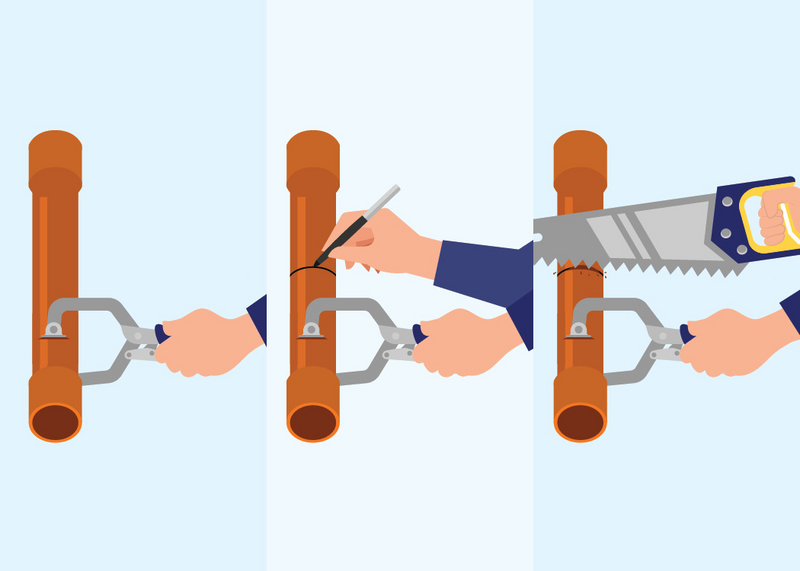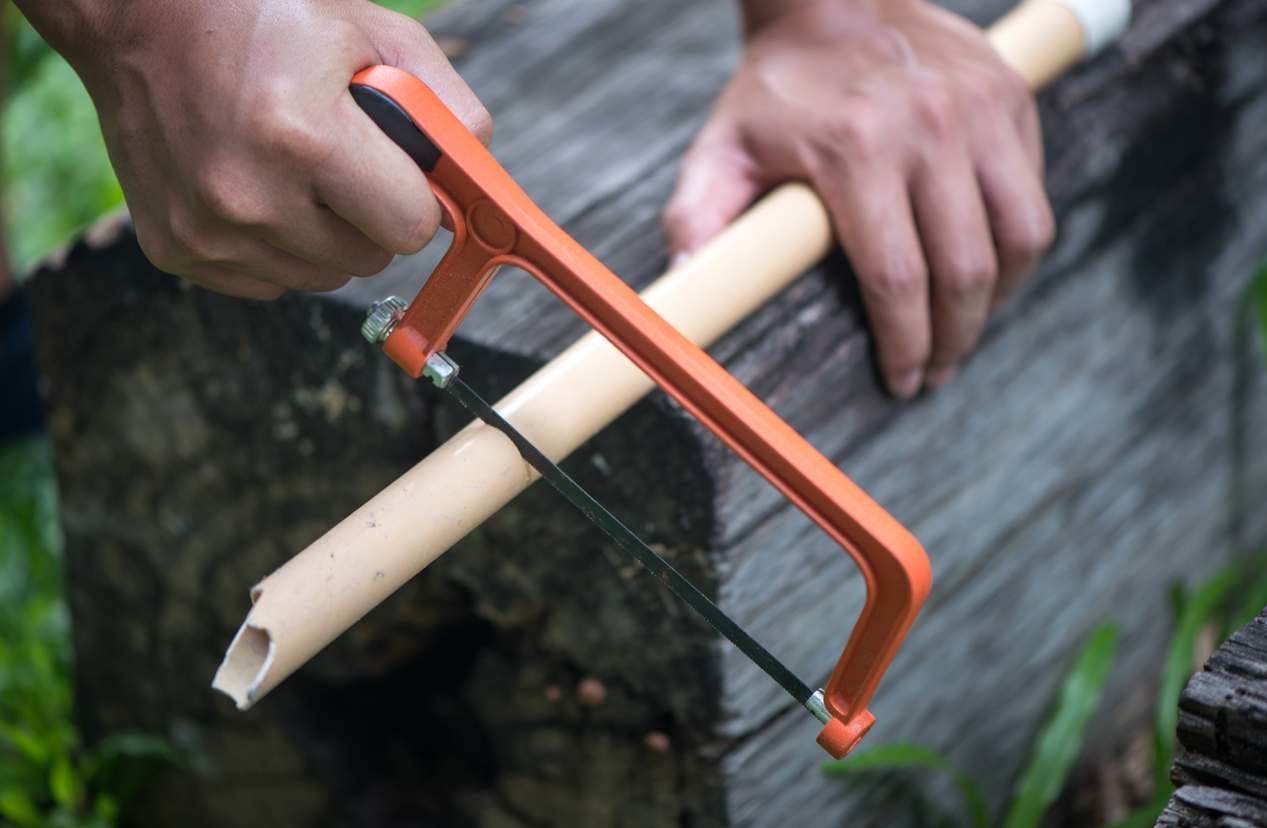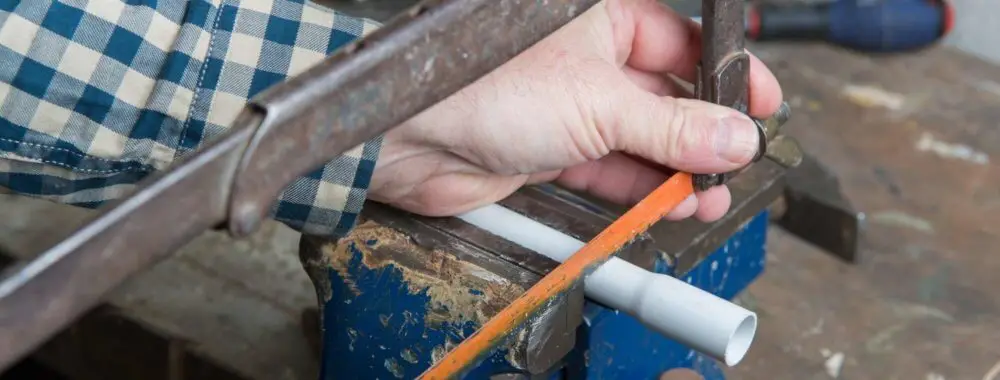Are you looking to learn how to cut PVC pipes?
Even if you’re not a repairman, understanding the proper techniques for cutting PVC pipe is essential for successful projects.
But if you are inexperienced, you might find this process rather frustrating. This is why everyone should learn how to cut PVC pipe straight and the right way.
PVC pipe is a plastic tube that is usually used for drains and plumbing around the house. If you see those white pipes in residential basements that have purple primer, these are most likely made from PVC.
If you don’t know how to cut PVC pipe properly, this activity can be hard and annoying. Luckily for you, we have prepared this guide to help you through the process.
Read Also: How to Identify Polybutylene Pipes
Before You Cut

You can’t cut a PVC pipe before you’ve done some preparation. When you think about how to cut PVC pipe at home, you should know where to start.
The first thing you should do is lubricate it, to make the cutting process more comfortable. Lubricants help lower the friction, which will make the blade glade without any issues.
At the same time, oils will prevent particles from polluting the air around you. When choosing a lubricant, always try to stick to a product with a silicone base.
Food-grade lubricants can also work – for example, cooking oil is a good pick. Always make sure to find lubricants that are safe to use on plastic, as some will eat the plastic away.
Try not to go overboard – too much lubrication will make everything messier than you’d like it!
If you want to know a good trick on how to cut PVC pipe straight, you should prepare a bucket. Yes, you’ve read that correctly.
A bucket can help you hold the PVC pipe in place. Just make sure that you’ve found a big bucket, then make two ‘v-cuts’ on top of it. Don’t worry – these cuts won’t ruin the functionality of your bucket if done correctly.
Also, you should always know that there are some precautionary measures you should take. Cutting tools can be dangerous.
How to Cut a PVC Pipe?

There isn’t one easiest way to cut a PVC pipe. The method you’ll choose depends on your preferences, as well as on the type of cut you’d like to make. In further text, we’ll give you a few examples of what to use to cut PVC pipe.
First off, there are some basic tools that you can use to cut the pipe. Some of these tools are present in the homes of most DIY lovers. On the other hand, some specialty tools are made strictly for PVC cutting.
Some of the basic tools are:
- PVC Pipe Cutters: PVC pipe cutters are specifically designed for cutting PVC pipes. They come in various sizes, ranging from handheld cutters for smaller pipes to larger ratcheting cutters for bigger pipes. PVC pipe cutters provide clean and precise cuts, making them a popular choice among DIYers and professionals alike.
- Hacksaw: A hacksaw with a fine-toothed blade can also be used to cut PVC pipe. It is a versatile tool that can cut through different materials, including PVC. Ensure that you use a fresh blade to ensure clean cuts. Keep in mind that using a hacksaw requires more effort compared to PVC pipe cutters.
- Miter Saw: If you have a miter saw or a circular saw with a fine-toothed blade, it can be an excellent option for cutting PVC pipe, especially for larger diameter pipes. These power tools provide fast and accurate cuts, making them ideal for large-scale projects. Ensure that you secure the pipe firmly and use appropriate safety precautions when using power tools.
- Rotary Pipe Cutter: A rotary pipe cutter is a handy tool for cutting PVC pipe in tight spaces or when working with pipes close to walls or other obstructions. It features a cutting wheel that is rotated around the pipe, gradually cutting through the material as you apply pressure. Rotary pipe cutters are particularly useful for cutting pipes with larger diameters.
On the other hand, we have specialty cutters, such as:
- PVC Cutters
- Scissor-style pipe cutters
- Ratchet-style pipe cutters
- Tubing cutters
We’ll cover some of the most commonly used cutting methods, and try to guide you through the process.
How to Cut PVC Pipe with a Handsaw?

Using a handsaw is the most common way of cutting almost anything. In fact, this tool is the most common choice on what to cut PVC pipe with.
Keep in mind that you probably won’t get a straight cut with it. Still, you should go slowly to make the blade stay on course as much as possible.
Never simply jam the knife into the pipe, as this will make the cut uneven. Use the bucket mentioned above method to keep the tube in place.
A handsaw is also useful if you wondered how to cut PVC pipe lengthwise. It will take a long time, but you’ll have more control than with any other tool.
How to Cut PVC Pipe with a Milter Saw?
If you want to learn how to cut PVC pipe straight, a milter saw might be the best tool for you. With milter saws, you are guaranteed to make a straight cut, as these saws have preset angles. This is perhaps the easiest way to cut PVC pipe.
Place the pipe alongside the edge of the milter saw, so you can easily see where the cut mark is. Then, line up the blade with the cut mark, lift the saw, and turn the blade on.
Keep lowering the edge down into the PVC pipe until you’ve done cutting. If you also wondered how to cut PVC pipe in half or how to cut PVC pipe at an angle – now you know that as well. Miter saws are the best for these tasks.
If by any chance you don’t cut all the way through at the first try, turn off the blade. Then, you should turn the pipe around so that the second drop can cut it without any problems.
Never attempt turning the tube while the module is still on! Not only is this not safe, but doing this will make an inaccurate cut.
How to Cut PVC Pipe with PVC Cutters?

The obvious and easy way to cut PVC pipe is with PVC cutters. This method is reasonably safe, and you won’t need to use a lot of force.
Keep in mind that if you wanted to know how to cut 3 inch PVC pipe, this probably wouldn’t work. Most PVC cutters can only cut thinner tubes, usually up to 1 or 2 inches in thickness.
There are some heavy-duty PVC cutters, but even those won’t work on pipes that are bigger than 2 inches.
With all this in mind, PVC cutters are best used on smaller DIY projects. Cutting plumbing pipes would require different, more potent tools. [1]
How to Cut PVC Pipe Straight with Sawzall?
Most people know how to cut PVC pipe with Sawzall, however, cutting it straight is a different story. First off, you should firmly press the blade against the pipe itself.
The more pressure you put on it, the less will Sawzall vibrate. Find the speed that will work for you.
The more you squeeze, the faster will the blade go. Make sure to go slow when starting, and later you can adjust it to full speed.
Also, try to use smaller Sawzall, as they are easier to control. The blade should be short as well, as longer blades tend to be unstable.
How to Cut PVC Pipe with String?
Lastly, we’ll mention one tool that you’d probably never imagine can cut a PVC pipe. Believe it or not, it is possible to cut a PVC pipe with a string.
This method isn’t as quick as some other ones. Still, if you wondered how to cut PVC pipe without a saw, this can be an excellent method to try.
Cutting a PVC pipe with a string is a suitable method if you can’t reach it with a saw. The first thing you should do is to make a small cut on the pipe using a utility knife.
Then, take a nylon string and pull it back and forth into the cut. Most PVC pipes are soft enough for nylon to rip trough them.
Keep in mind that this method isn’t precise and that it can take up to five minutes. However, if you have wondered how to cut PVC pipe without tools, this is the way to do it.
Read Also: Different Types of PVC Pipes
Deburring
Deburring, or cleaning burrs, is the final and optional step of any pipe-cutting method. Most cuts won’t be perfect, especially if you are a beginner. In other words, there will be some burrs left.
This isn’t concerning, and on most occasions, it won’t ruin your project. However, it would be highly advisable to deburr the edges, just in case.
Some burrs can destroy a perfect fit or even cause clogged filters later on. You don’t want to risk weakening pipe connections over time.
One of the ways to deburr a cut PVC pipe is to use a utility knife. The process itself is simple – just run the knife over the uneven edges until they are smooth.
Make sure to clog the pipe with some cloth first. This is done to prevent plastic bits from falling inside the tube.
You can also use sandpaper to smoothen the edges out. If you did an awful job making a straight cut, you could mix these two methods. This is the recommended way, as you will be able to deburr everything quickly and precisely.
Keep in mind that although deburring isn’t required, you should do it, especially if the pipes at questions are important ones. For example, pipes used for plumbing should always have fine edges. [2]
Read Also: Sings of Water Damage Under Floor
Conclusion
Everyone can learn how to cut PVC pipe. It’s pretty handy when you need to replace leaking pvc pipe. The process itself isn’t complicated, and it only requires a little bit of practice.
Don’t get discouraged if you don’t make a perfect cut right away. No one was born a genius, and you need to get your hands used to the cutting process.
We hope that some of the tips and tricks we gave to you will help you.
The tool you use depends on your preference, strength and expectations. Once you become handy in this process, any device will work equally!
And remember, always be cautious when working with sharp tools! Saws can cause severe damage, and some of them can even cut through bones.

Michael Davis is a heating & plumbing expert who currently works as independent contractor in SC. He also writes for Plumbertip.
For almost 10 years he worked on various plumbing tasks across South Carolina.


